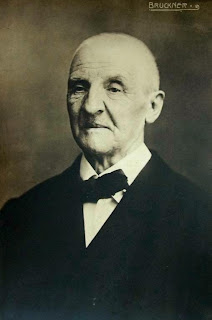Information
Composer: Anton Bruckner
- Symphony No. 1 in C minor (1866, ed. Carragan): I. Allegro
- Symphony No. 1 in C minor (1866, ed. Carragan): II. Adagio
- Symphony No. 1 in C minor (1866, ed. Carragan): III. Scherzo. Schnell
- Symphony No. 1 in C minor (1866, ed. Carragan): IV. Finale. Bewegt, feurig
- Symphony No. 3 in D minor (1876, ed. Nowak): II. Adagio
Royal Scottish National Orchestra
Georg Tintner, conductor
Date:
Label: Naxos
http://www.naxos.com/catalogue/item.asp?item_code=8.554430
----------------------------------------------------------------
ARTISTIC QUALITY: 10 / SOUND QUALITY: 10
This edition of Bruckner’s First Symphony purports to be the “really original” Linz version, though the differences between it and what we know as the standard Linz version are minimal. Similarly, the differences between this affectionately played 1876 revision of the slow movement of Symphony No. 3 and its various other incarnations will raise few eyebrows. A far better reason to buy this recording is the quality of the performances themselves. This is the last of Georg Tintner’s Bruckner recordings for Naxos, and it’s one of the best. All of the qualities that make Tintner’s performances so special are here. There’s his typically intelligent delineation of the first movement’s formal structure through flexible tempos that enhance, rather than disturb, the music’s natural momentum. Also much in evidence: careful balances between strings and winds, particularly at such moments as the “Tannhäuser” theme, where the temptation to let the brass blast is difficult to resist. Instead, Tintner offers full, noble tone (aided by some terrific trombone playing). He then invests the slow movement with a simple purity of expression that goes straight to the heart of this sublime piece. In fact, there isn’t anything in this performance that Tintner does wrong. The rhythmic dynamo of a scherzo leads into a finale that seems to play itself, so effortless is Tintner’s command of Bruckner’s sense of scale and pacing. The recent, tragic death of this fine artist was a loss to music lovers everywhere, but in consistently fulfilling the very special promise of his Bruckner recordings for Naxos, he has left us an enduring musical testament that will keep his memory and work alive for generations. And that is cause for celebration, which I am sure is how Tintner himself would have wanted it. Listen, and enjoy!
-- David Hurwitz, ClassicsToday
More reviews:
http://www.gramophone.co.uk/review/bruckner-symphony-no-1-3
http://www.musicweb-international.com/classrev/2000/june00/Tintner.htm
http://www.amazon.com/Bruckner-Symphony-Version-Carragan-Adagio/dp/B00004SYFQ
http://www.naxos.com/reviews/reviewslist.asp?catalogueid=8.554430&languageid=EN
More reviews:
http://www.gramophone.co.uk/review/bruckner-symphony-no-1-3
http://www.musicweb-international.com/classrev/2000/june00/Tintner.htm
http://www.amazon.com/Bruckner-Symphony-Version-Carragan-Adagio/dp/B00004SYFQ
http://www.naxos.com/reviews/reviewslist.asp?catalogueid=8.554430&languageid=EN
----------------------------------------------------------------
Anton Bruckner (4 September 1824 – 11 October 1896)) was an Austrian composer. His symphonies are considered emblematic of the final stage of Austro-German Romanticism because of their rich harmonic language, strongly polyphonic character, and considerable length. Bruckner composed eleven symphonies, scored for a fairly standard orchestra. His orchestration was modeled after the sound of his primary instrument, the pipe organ.
http://en.wikipedia.org/wiki/Anton_Bruckner
http://en.wikipedia.org/wiki/Anton_Bruckner
***
Georg Tintner (22 May 1917 – 2 October 1999) was an Austrian-born conductor whose career was principally in New Zealand, Australia, and Canada. Although best known as a conductor, he was also a composer (he considered himself a composer who conducted). Tintner was described as "one of the greatest living Bruckner conductors." He recorded a much-praised complete cycle of Bruckner symphonies for the Naxos CD label shortly before the end of his life.
http://en.wikipedia.org/wiki/Georg_Tintner
http://en.wikipedia.org/wiki/Georg_Tintner
----------------------------------------------------------------
FLAC, tracks
Links in comment
Enjoy!



MEGA
ReplyDeletehttp://adf.ly/1HTcDf
EmbedUpload
http://adf.ly/1HTcDg
booklet
Deletehttps://mega.nz/#!cgIwRQKA!ZeBxkWvVQ7eRwIbZb3Fl3nApThRQ_fnBukOf1U-9rC4
muchas gracias ronald do!
ReplyDelete